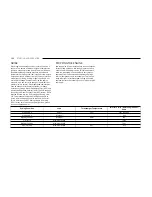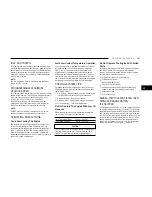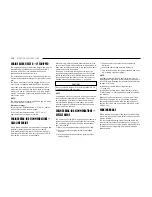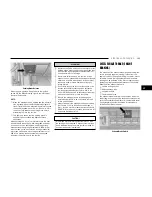
Preferred Procedure
1. With the engine running, slow the vehicle to 2 to
3 mph (3 to 5 km/h).
2. Shift the transmission into NEUTRAL.
3. While still rolling, push the desired position on the
transfer case control switch.
4. After the desired position indicator light is on (not
flashing), shift the transmission back into gear.
Alternate Procedure
1. Bring the vehicle to a complete stop.
2. With the ignition switch in the ON/RUN position and
the engine running, shift the transmission into
NEUTRAL.
3. Push the desired position on the transfer case con-
trol switch.
4. After the desired position indicator light is on (not
flashing), shift the transmission back into gear.
NOTE:
•
If Steps 1 or 2 of either the Preferred or Alternate
Procedure are not satisfied prior to attempting the
shift, then the desired position indicator light will
flash continuously while the original position indica-
tor light is on, until all requirements have been met.
•
The ignition switch must be in the ON/RUN position
for a shift to take place and for the position indica-
tor lights to be operable. If the ignition switch is not
in the ON/RUN position, the shift will not take place
and no position indicator lights will be on or
flashing.
ELECTRONICALLY SHIFTED
TRANSFER CASE (6-SPEED
TRANSMISSION) — IF EQUIPPED
The electronically shifted transfer case is operated by
the four-wheel drive Control Switch (Transfer Case
Switch), which is located on the instrument panel.
This electronically shifted transfer case provides four
positions:
•
Two-Wheel Drive High Range (2WD)
•
Four-Wheel Drive High Range (4WD HIGH)
•
Four-Wheel Drive Low Range (4WD LOW)
•
N (Neutral)
For additional information on the appropriate use of
each transfer case position, see the following
information:
2WD
Two-Wheel Drive High Range — This range is for normal
street and highway driving on dry, hard surfaced roads.
4WD HIGH
Four-Wheel Drive High Range — This range maximizes
torque to the front driveshaft, forcing the front and rear
wheels to rotate at the same speed. This range pro-
vides additional traction for loose, slippery road sur-
faces only.
4WD LOW
Four-Wheel Drive Low Range — This range provides low
speed four-wheel drive. It maximizes torque to the front
wheels, forcing the front and rear wheels to rotate at
the same speed. This range provides additional traction
and maximum pulling power for loose, slippery road
surfaces only. Do not exceed 25 mph (40 km/h).
N (Neutral)
N (Neutral) — This range disengages both the front and
rear driveshafts from the powertrain. To be used for flat
towing behind another vehicle
WARNING!
You or others could be injured or killed if you leave
the vehicle unattended with the transfer case in the N
(Neutral) position without first fully engaging the park-
ing brake. The transfer case N (Neutral) position dis-
engages both the front and rear drive shafts from the
powertrain and will allow the vehicle to roll, even if
the transmission is in PARK. The parking brake
should always be applied when the driver is not in the
vehicle.
This electronically shifted transfer case is designed to
be driven in the two-wheel drive position (2WD) for nor-
mal street and highway conditions on dry, hard sur-
faced roads.
Four-Position/Part-Time Transfer Case
120
STARTING AND OPERATING
Summary of Contents for CHASSIS CAB 2024
Page 69: ...GETTING TO KNOW YOUR INSTRUMENT PANEL MIDLINE INSTRUMENT CLUSTER GASOLINE 67 3...
Page 71: ...HIGHLINE INSTRUMENT CLUSTER GASOLINE GETTING TO KNOW YOUR INSTRUMENT PANEL 69 3...
Page 75: ...MIDLINE INSTRUMENT CLUSTER DIESEL GETTING TO KNOW YOUR INSTRUMENT PANEL 73 3...
Page 77: ...HIGHLINE INSTRUMENT CLUSTER DIESEL GETTING TO KNOW YOUR INSTRUMENT PANEL 75 3...
Page 357: ......
Page 358: ......



































